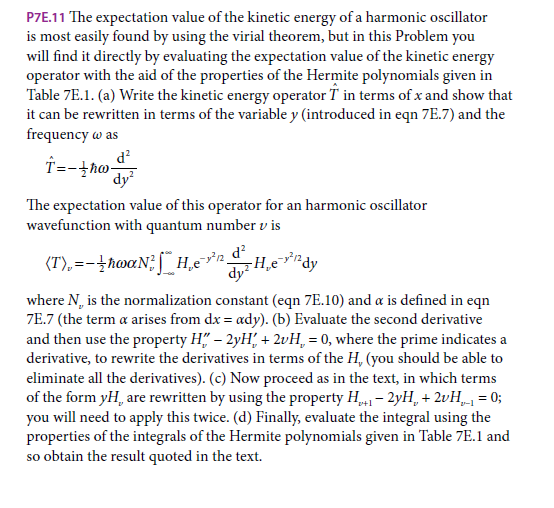P7E.11 The expectation value of the kinetic energy of a harmonic oscillator is most easily found by using the virial theorem, but in this Problem you will find it directly by evaluating the expectation value of the kinetic energy operator with the aid of the properties of the Hermite polynomials given in Table 7E.1. (a) Write the kinetic energy operator T in terms of x and show that it can be rewritten in terms of the variable y (introduced in eqn 7E.7) and the frequency w as d? dy The expectation value of this operator for an harmonic oscillator wavefunction with quantum number v is d? (T),=-hwaN; ſ H,en. dy H,evirdy where N, is the normalization constant (eqn 7E.10) and a is defined in eqn 7E.7 (the term a arises from dx = ady). (b) Evaluate the second derivative and then use the property H" – 2yH, + 2vH, = 0, where the prime indicates a derivative, to rewrite the derivatives in terms of the H, (you should be able to eliminate all the derivatives). (c) Now proceed as in the text, in which terms of the form yH, are rewritten by using the property H - 2yH, + 2vH„ = 0; you will need to apply this twice. (d) Finally, evaluate the integral using the properties of the integrals of the Hermite polynomials given in Table 7E.1 and so obtain the result quoted in the text.
P7E.11 The expectation value of the kinetic energy of a harmonic oscillator is most easily found by using the virial theorem, but in this Problem you will find it directly by evaluating the expectation value of the kinetic energy operator with the aid of the properties of the Hermite polynomials given in Table 7E.1. (a) Write the kinetic energy operator T in terms of x and show that it can be rewritten in terms of the variable y (introduced in eqn 7E.7) and the frequency w as d? dy The expectation value of this operator for an harmonic oscillator wavefunction with quantum number v is d? (T),=-hwaN; ſ H,en. dy H,evirdy where N, is the normalization constant (eqn 7E.10) and a is defined in eqn 7E.7 (the term a arises from dx = ady). (b) Evaluate the second derivative and then use the property H" – 2yH, + 2vH, = 0, where the prime indicates a derivative, to rewrite the derivatives in terms of the H, (you should be able to eliminate all the derivatives). (c) Now proceed as in the text, in which terms of the form yH, are rewritten by using the property H - 2yH, + 2vH„ = 0; you will need to apply this twice. (d) Finally, evaluate the integral using the properties of the integrals of the Hermite polynomials given in Table 7E.1 and so obtain the result quoted in the text.
Related questions
Question

Transcribed Image Text:P7E.11 The expectation value of the kinetic energy of a harmonic oscillator
is most easily found by using the virial theorem, but in this Problem you
will find it directly by evaluating the expectation value of the kinetic energy
operator with the aid of the properties of the Hermite polynomials given in
Table 7E.1. (a) Write the kinetic energy operator T in terms of x and show that
it can be rewritten in terms of the variable y (introduced in eqn 7E.7) and the
frequency w as
d?
dy
The expectation value of this operator for an harmonic oscillator
wavefunction with quantum number v is
d?
(T),=-hwaN; ſ H,en.
dy H,evirdy
where N, is the normalization constant (eqn 7E.10) and a is defined in eqn
7E.7 (the term a arises from dx = ady). (b) Evaluate the second derivative
and then use the property H" – 2yH, + 2vH, = 0, where the prime indicates a
derivative, to rewrite the derivatives in terms of the H, (you should be able to
eliminate all the derivatives). (c) Now proceed as in the text, in which terms
of the form yH, are rewritten by using the property H - 2yH, + 2vH„ = 0;
you will need to apply this twice. (d) Finally, evaluate the integral using the
properties of the integrals of the Hermite polynomials given in Table 7E.1 and
so obtain the result quoted in the text.
Expert Solution
This question has been solved!
Explore an expertly crafted, step-by-step solution for a thorough understanding of key concepts.
This is a popular solution!
Trending now
This is a popular solution!
Step by step
Solved in 3 steps
